brake pads INFINITI QX80 2021 Owner's Manual
[x] Cancel search | Manufacturer: INFINITI, Model Year: 2021, Model line: QX80, Model: INFINITI QX80 2021Pages: 529, PDF Size: 2.05 MB
Page 3 of 529
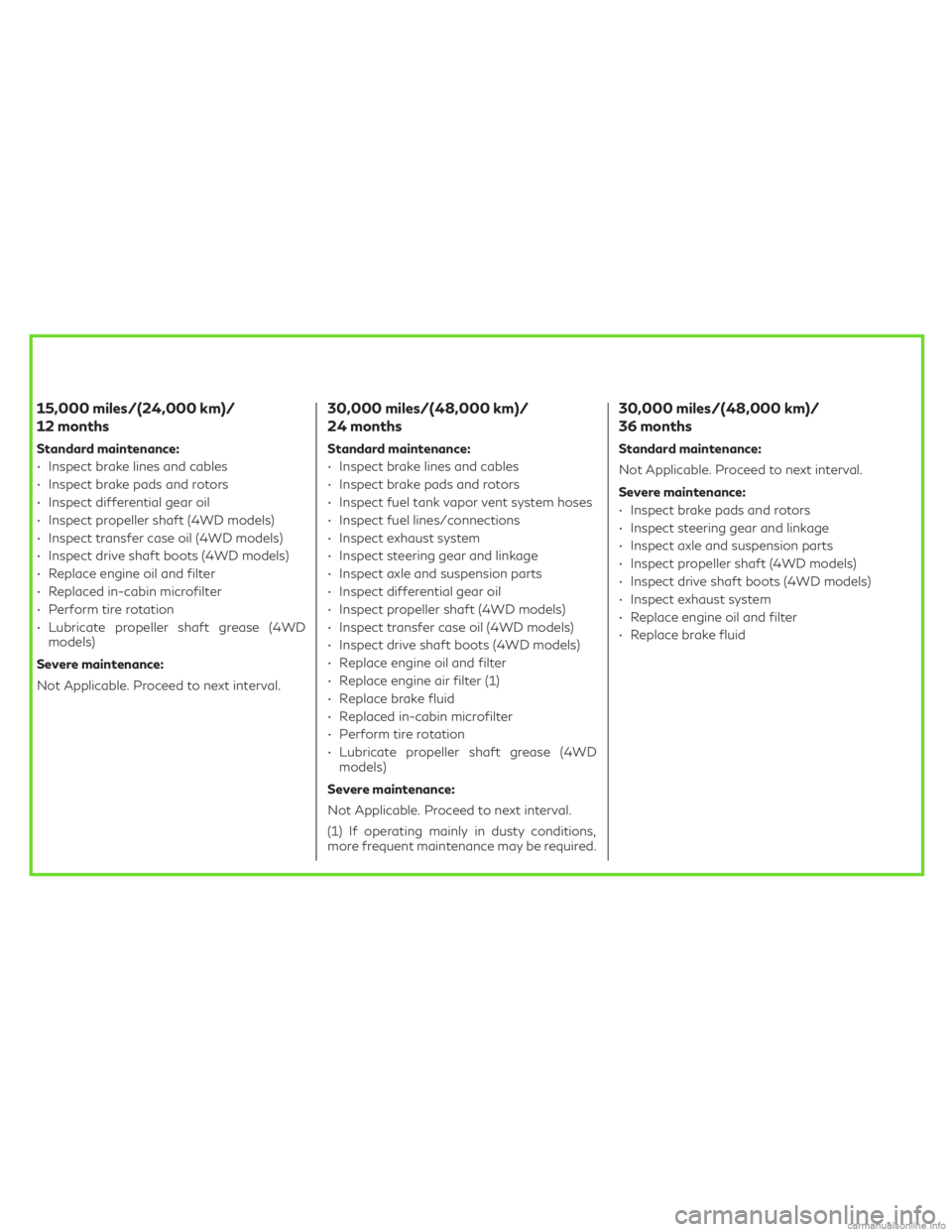
15,000 miles/(24,000 km)/
12 months
Standard maintenance:
• Inspect brake lines and cables
• Inspect brake pads and rotors
• Inspect differential gear oil
• Inspect propeller shaft (4WD models)
• Inspect transfer case oil (4WD models)
• Inspect drive shaft boots (4WD models)
• Replace engine oil and filter
• Replaced in-cabin microfilter
• Perform tire rotation
• Lubricate propeller shaft grease (4WD
models)
Severe maintenance:
Not Applicable. Proceed to next interval.
30,000 miles/(48,000 km)/
24 months
Standard maintenance:
• Inspect brake lines and cables
• Inspect brake pads and rotors
• Inspect fuel tank vapor vent system hoses
• Inspect fuel lines/connections
• Inspect exhaust system
• Inspect steering gear and linkage
• Inspect axle and suspension parts
• Inspect differential gear oil
• Inspect propeller shaft (4WD models)
• Inspect transfer case oil (4WD models)
• Inspect drive shaft boots (4WD models)
• Replace engine oil and filter
• Replace engine air filter (1)
• Replace brake fluid
• Replaced in-cabin microfilter
• Perform tire rotation
• Lubricate propeller shaft grease (4WD
models)
Severe maintenance:
Not Applicable. Proceed to next interval.
(1) If operating mainly in dusty conditions,
more frequent maintenance may be required.
30,000 miles/(48,000 km)/
36 months
Standard maintenance:
Not Applicable. Proceed to next interval.
Severe maintenance:
• Inspect brake pads and rotors
• Inspect steering gear and linkage
• Inspect axle and suspension parts
• Inspect propeller shaft (4WD models)
• Inspect drive shaft boots (4WD models)
• Inspect exhaust system
• Replace engine oil and filter
• Replace brake fluid
Page 4 of 529
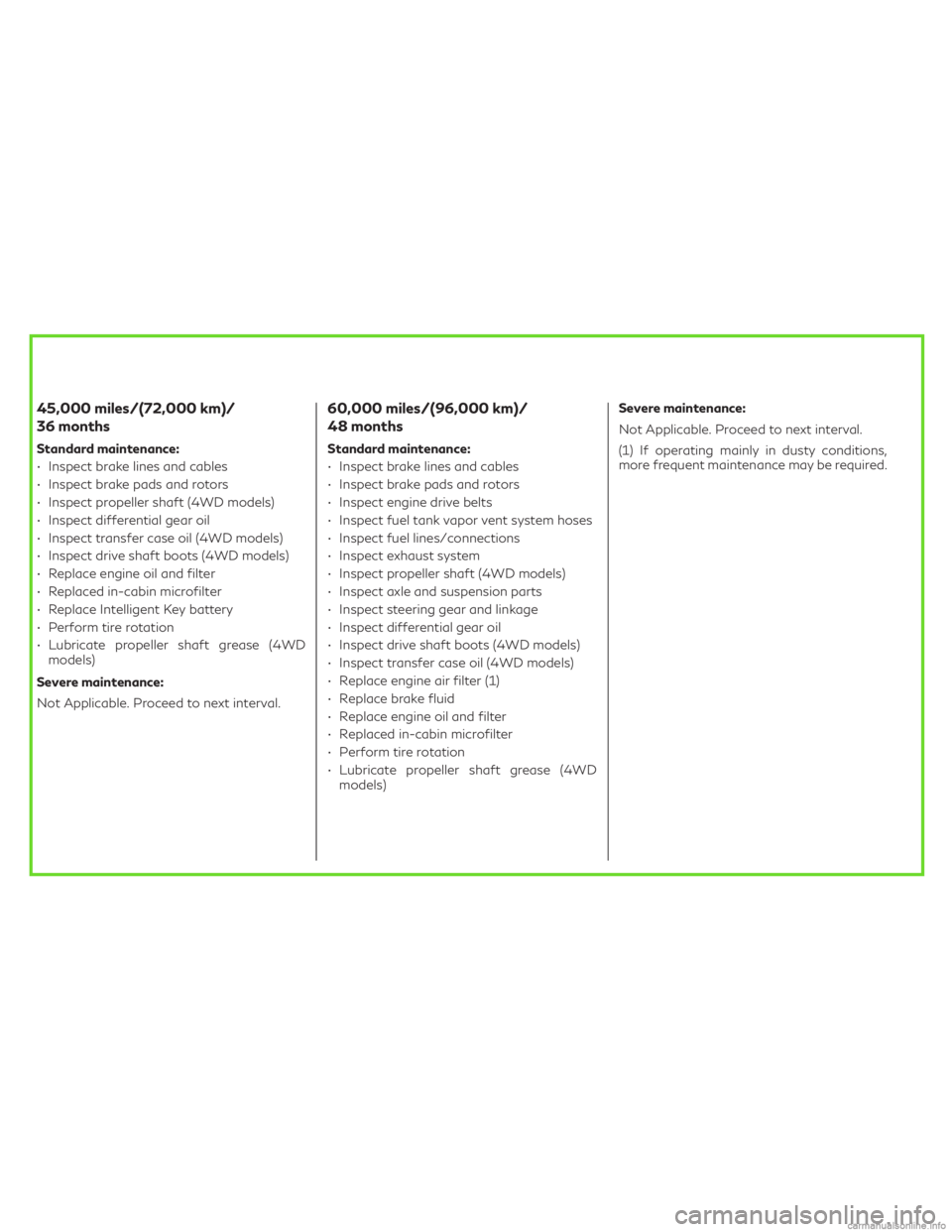
45,000 miles/(72,000 km)/
36 months
Standard maintenance:
• Inspect brake lines and cables
• Inspect brake pads and rotors
• Inspect propeller shaft (4WD models)
• Inspect differential gear oil
• Inspect transfer case oil (4WD models)
• Inspect drive shaft boots (4WD models)
• Replace engine oil and filter
• Replaced in-cabin microfilter
• Replace Intelligent Key battery
• Perform tire rotation
• Lubricate propeller shaft grease (4WD
models)
Severe maintenance:
Not Applicable. Proceed to next interval.
60,000 miles/(96,000 km)/
48 months
Standard maintenance:
• Inspect brake lines and cables
• Inspect brake pads and rotors
• Inspect engine drive belts
• Inspect fuel tank vapor vent system hoses
• Inspect fuel lines/connections
• Inspect exhaust system
• Inspect propeller shaft (4WD models)
• Inspect axle and suspension parts
• Inspect steering gear and linkage
• Inspect differential gear oil
• Inspect drive shaft boots (4WD models)
• Inspect transfer case oil (4WD models)
• Replace engine air filter (1)
• Replace brake fluid
• Replace engine oil and filter
• Replaced in-cabin microfilter
• Perform tire rotation
• Lubricate propeller shaft grease (4WD
models)Severe maintenance:
Not Applicable. Proceed to next interval.
(1) If operating mainly in dusty conditions,
more frequent maintenance may be required.
Page 5 of 529
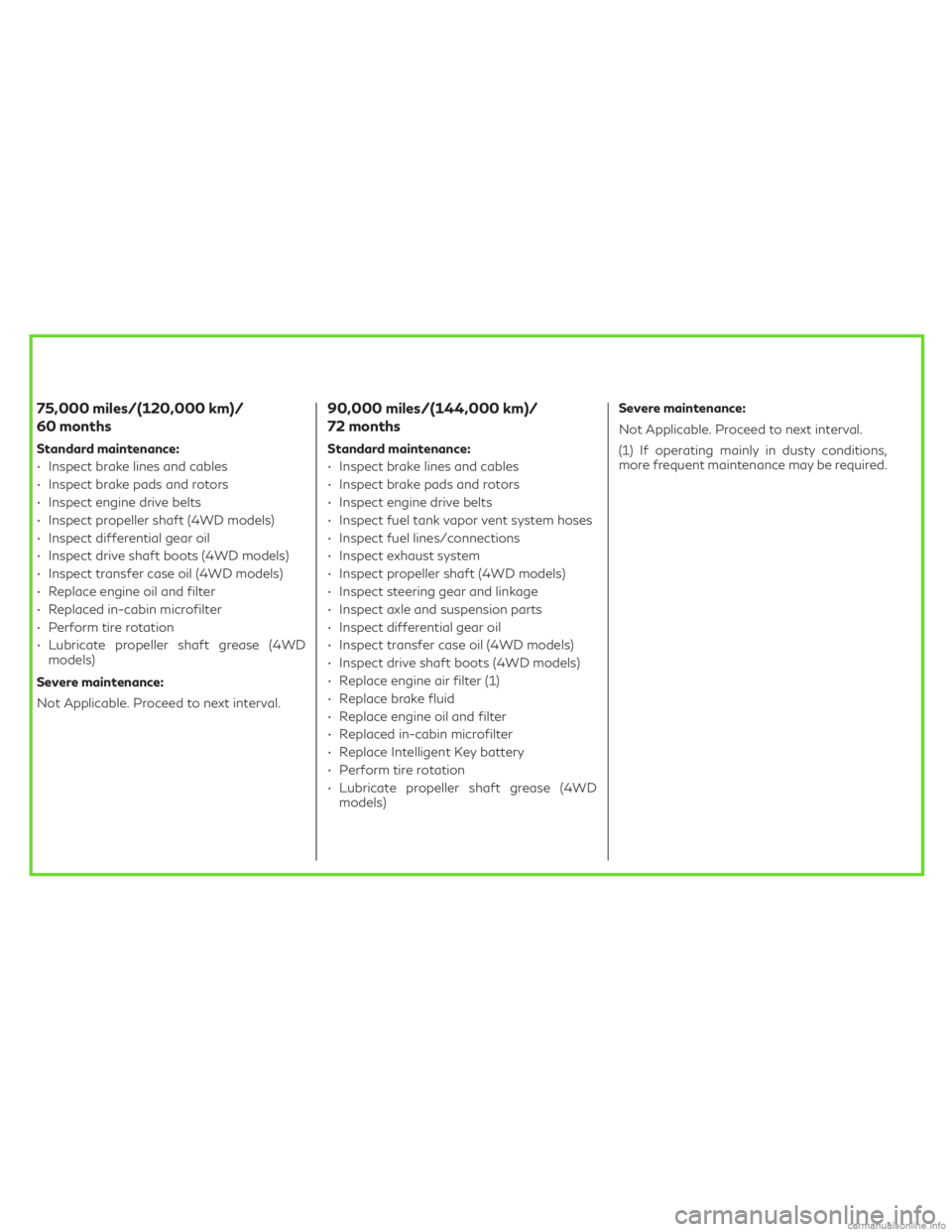
75,000 miles/(120,000 km)/
60 months
Standard maintenance:
• Inspect brake lines and cables
• Inspect brake pads and rotors
• Inspect engine drive belts
• Inspect propeller shaft (4WD models)
• Inspect differential gear oil
• Inspect drive shaft boots (4WD models)
• Inspect transfer case oil (4WD models)
• Replace engine oil and filter
• Replaced in-cabin microfilter
• Perform tire rotation
• Lubricate propeller shaft grease (4WD
models)
Severe maintenance:
Not Applicable. Proceed to next interval.
90,000 miles/(144,000 km)/
72 months
Standard maintenance:
• Inspect brake lines and cables
• Inspect brake pads and rotors
• Inspect engine drive belts
• Inspect fuel tank vapor vent system hoses
• Inspect fuel lines/connections
• Inspect exhaust system
• Inspect propeller shaft (4WD models)
• Inspect steering gear and linkage
• Inspect axle and suspension parts
• Inspect differential gear oil
• Inspect transfer case oil (4WD models)
• Inspect drive shaft boots (4WD models)
• Replace engine air filter (1)
• Replace brake fluid
• Replace engine oil and filter
• Replaced in-cabin microfilter
• Replace Intelligent Key battery
• Perform tire rotation
• Lubricate propeller shaft grease (4WD
models)Severe maintenance:
Not Applicable. Proceed to next interval.
(1) If operating mainly in dusty conditions,
more frequent maintenance may be required.
Page 6 of 529
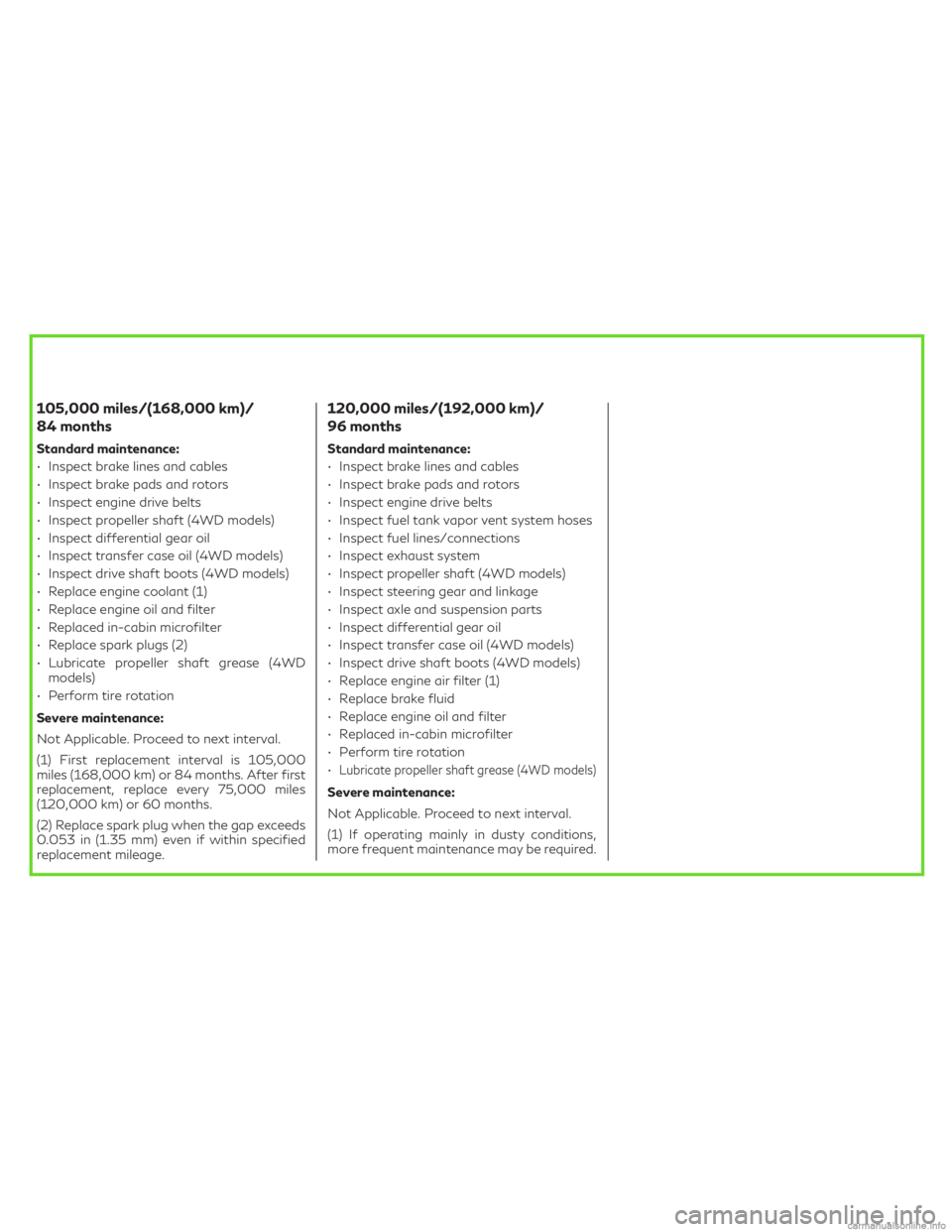
105,000 miles/(168,000 km)/
84 months
Standard maintenance:
• Inspect brake lines and cables
• Inspect brake pads and rotors
• Inspect engine drive belts
• Inspect propeller shaft (4WD models)
• Inspect differential gear oil
• Inspect transfer case oil (4WD models)
• Inspect drive shaft boots (4WD models)
• Replace engine coolant (1)
• Replace engine oil and filter
• Replaced in-cabin microfilter
• Replace spark plugs (2)
• Lubricate propeller shaft grease (4WD
models)
• Perform tire rotation
Severe maintenance:
Not Applicable. Proceed to next interval.
(1) First replacement interval is 105,000
miles (168,000 km) or 84 months. After first
replacement, replace every 75,000 miles
(120,000 km) or 60 months.
(2) Replace spark plug when the gap exceeds
0.053 in (1.35 mm) even if within specified
replacement mileage.
120,000 miles/(192,000 km)/
96 months
Standard maintenance:
• Inspect brake lines and cables
• Inspect brake pads and rotors
• Inspect engine drive belts
• Inspect fuel tank vapor vent system hoses
• Inspect fuel lines/connections
• Inspect exhaust system
• Inspect propeller shaft (4WD models)
• Inspect steering gear and linkage
• Inspect axle and suspension parts
• Inspect differential gear oil
• Inspect transfer case oil (4WD models)
• Inspect drive shaft boots (4WD models)
• Replace engine air filter (1)
• Replace brake fluid
• Replace engine oil and filter
• Replaced in-cabin microfilter
• Perform tire rotation
•
Lubricate propeller shaft grease (4WD models)
Severe maintenance:
Not Applicable. Proceed to next interval.
(1) If operating mainly in dusty conditions,
more frequent maintenance may be required.
Page 116 of 529

WARNING/INDICATOR LIGHTS
(other)
See “Vehicle information display” (P.2-20).
Exterior light indicator
This indicator illuminates when the headlight
switch is turned to the AUTO,orposition and the front parking lights, instru-
ment panel lights, rear combination lights,
license plate lights or headlights are on. The
indicator turns off when these lights are
turned off.
Front fog light indicator light
The front fog light indicator light illuminates
when the front fog lights are on. (See “Fog
light switch” (P.2-47).)
Front passenger air bag status
light
The front passenger air bag status light
() located on the instrument panel will be
lit and the passenger front air bag will be
OFF depending on how the front passenger
seat is being used.
For front passenger air bag status light
operation, see “INFINITI Advanced Air Bag
System (front seats)” (P.1-58).
High beam assist indicator
light
The indicator light illuminates when the
headlights come on while the headlight
switch is in the AUTO position with the high
beam selected. This indicates that the high
beam assist system is operational. (See
“High beam assist” (P.2-41).)
High beam indicator light
This light comes on when the headlight high
beam is on and goes out when the low beam
is selected.
TOW mode indicator light
This light will illuminate when the TOW
mode is selected while the engine is running.
(See “TOW mode” (P.5-122).)
Turn signal/hazard indicator
lights
The light flashes when the turn signal switch
lever or hazard switch is turned on.
AUDIBLE REMINDERS
Key reminder chime
A chime will sound if the driver side door is
opened while the ignition switch is pushed to
the ACC position. Make sure the ignition
switch is pushed to the OFF position, and
take the Intelligent Key with you when
leaving the vehicle.
Light reminder chime
A chime will sound when the driver side door
is opened with the light switch in theorposition and the ignition switch in the
ACC, OFF or LOCK position.
Turn the light switch off when you leave the
vehicle.
Parking brake reminder chime
The chime will sound if the vehicle is driven
at more than 4 MPH (7 km/h) with the
parking brake applied. Stop the vehicle and
release the parking brake.
Brake pad wear warning
The disc brake pads have audible wear
warnings. When a brake pad requires repla-
cement, it will make a high pitched scraping
sound when the vehicle is in motion. This
scraping sound will first occur only when the
brake pedal is depressed. After more wear of
Instruments and controls2-19
Page 386 of 529
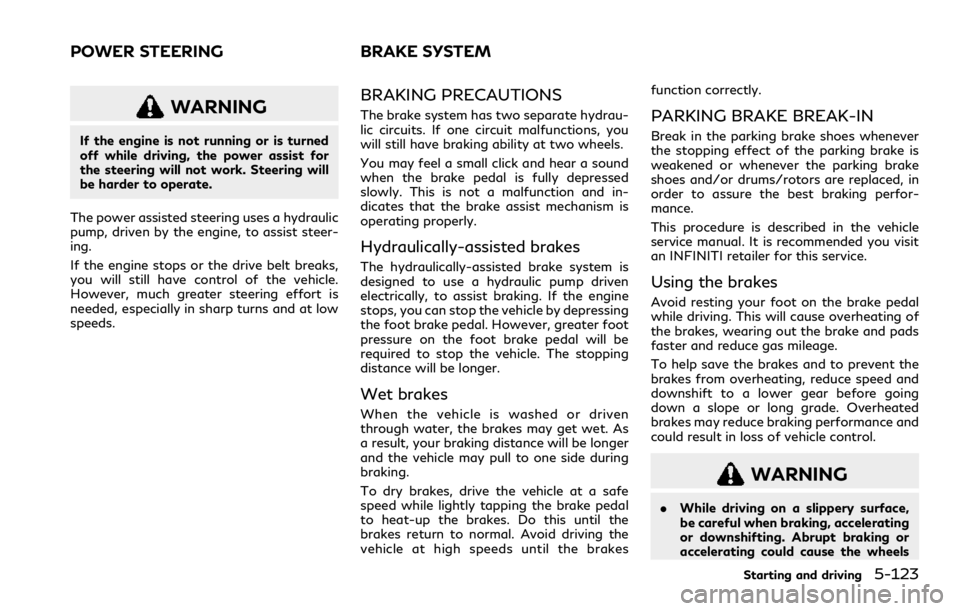
WARNING
If the engine is not running or is turned
off while driving, the power assist for
the steering will not work. Steering will
be harder to operate.
The power assisted steering uses a hydraulic
pump, driven by the engine, to assist steer-
ing.
If the engine stops or the drive belt breaks,
you will still have control of the vehicle.
However, much greater steering effort is
needed, especially in sharp turns and at low
speeds.
BRAKING PRECAUTIONS
The brake system has two separate hydrau-
lic circuits. If one circuit malfunctions, you
will still have braking ability at two wheels.
You may feel a small click and hear a sound
when the brake pedal is fully depressed
slowly. This is not a malfunction and in-
dicates that the brake assist mechanism is
operating properly.
Hydraulically-assisted brakes
The hydraulically-assisted brake system is
designed to use a hydraulic pump driven
electrically, to assist braking. If the engine
stops, you can stop the vehicle by depressing
the foot brake pedal. However, greater foot
pressure on the foot brake pedal will be
required to stop the vehicle. The stopping
distance will be longer.
Wet brakes
When the vehicle is washed or driven
through water, the brakes may get wet. As
a result, your braking distance will be longer
and the vehicle may pull to one side during
braking.
To dry brakes, drive the vehicle at a safe
speed while lightly tapping the brake pedal
to heat-up the brakes. Do this until the
brakes return to normal. Avoid driving the
vehicle at high speeds until the brakes function correctly.
PARKING BRAKE BREAK-IN
Break in the parking brake shoes whenever
the stopping effect of the parking brake is
weakened or whenever the parking brake
shoes and/or drums/rotors are replaced, in
order to assure the best braking perfor-
mance.
This procedure is described in the vehicle
service manual. It is recommended you visit
an INFINITI retailer for this service.
Using the brakes
Avoid resting your foot on the brake pedal
while driving. This will cause overheating of
the brakes, wearing out the brake and pads
faster and reduce gas mileage.
To help save the brakes and to prevent the
brakes from overheating, reduce speed and
downshift to a lower gear before going
down a slope or long grade. Overheated
brakes may reduce braking performance and
could result in loss of vehicle control.
WARNING
.
While driving on a slippery surface,
be careful when braking, accelerating
or downshifting. Abrupt braking or
accelerating could cause the wheels
Starting and driving5-123
POWER STEERING BRAKE SYSTEM
Page 389 of 529
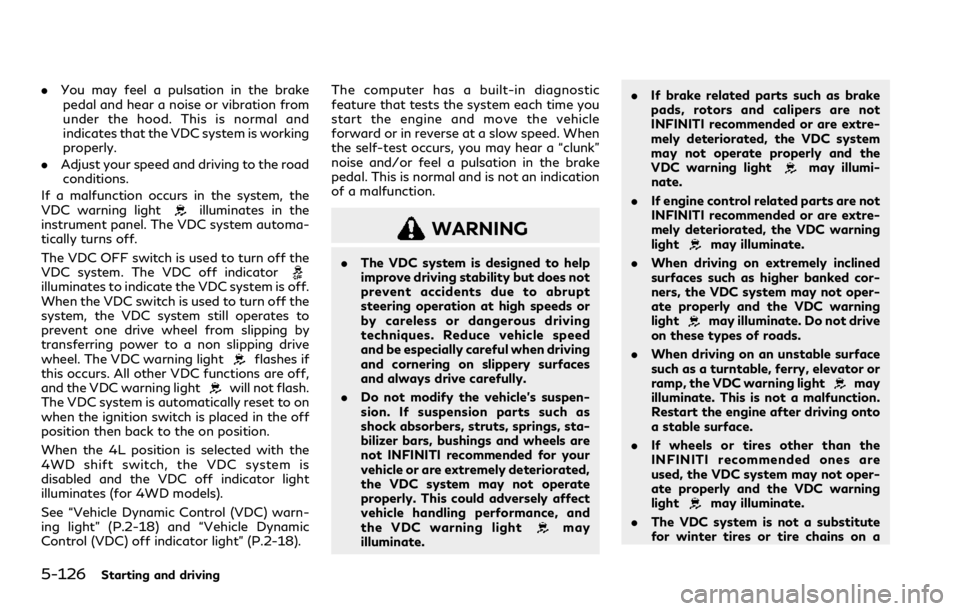
5-126Starting and driving
.You may feel a pulsation in the brake
pedal and hear a noise or vibration from
under the hood. This is normal and
indicates that the VDC system is working
properly.
. Adjust your speed and driving to the road
conditions.
If a malfunction occurs in the system, the
VDC warning light
illuminates in the
instrument panel. The VDC system automa-
tically turns off.
The VDC OFF switch is used to turn off the
VDC system. The VDC off indicator
illuminates to indicate the VDC system is off.
When the VDC switch is used to turn off the
system, the VDC system still operates to
prevent one drive wheel from slipping by
transferring power to a non slipping drive
wheel. The VDC warning light
flashes if
this occurs. All other VDC functions are off,
and the VDC warning light
will not flash.
The VDC system is automatically reset to on
when the ignition switch is placed in the off
position then back to the on position.
When the 4L position is selected with the
4WD shift switch, the VDC system is
disabled and the VDC off indicator light
illuminates (for 4WD models).
See “Vehicle Dynamic Control (VDC) warn-
ing light” (P.2-18) and “Vehicle Dynamic
Control (VDC) off indicator light” (P.2-18). The computer has a built-in diagnostic
feature that tests the system each time you
start the engine and move the vehicle
forward or in reverse at a slow speed. When
the self-test occurs, you may hear a “clunk”
noise and/or feel a pulsation in the brake
pedal. This is normal and is not an indication
of a malfunction.
WARNING
.
The VDC system is designed to help
improve driving stability but does not
prevent accidents due to abrupt
steering operation at high speeds or
by careless or dangerous driving
techniques. Reduce vehicle speed
and be especially careful when driving
and cornering on slippery surfaces
and always drive carefully.
. Do not modify the vehicle’s suspen-
sion. If suspension parts such as
shock absorbers, struts, springs, sta-
bilizer bars, bushings and wheels are
not INFINITI recommended for your
vehicle or are extremely deteriorated,
the VDC system may not operate
properly. This could adversely affect
vehicle handling performance, and
the VDC warning light
may
illuminate. .
If brake related parts such as brake
pads, rotors and calipers are not
INFINITI recommended or are extre-
mely deteriorated, the VDC system
may not operate properly and the
VDC warning light
may illumi-
nate.
. If engine control related parts are not
INFINITI recommended or are extre-
mely deteriorated, the VDC warning
light
may illuminate.
. When driving on extremely inclined
surfaces such as higher banked cor-
ners, the VDC system may not oper-
ate properly and the VDC warning
light
may illuminate. Do not drive
on these types of roads.
. When driving on an unstable surface
such as a turntable, ferry, elevator or
ramp, the VDC warning light
may
illuminate. This is not a malfunction.
Restart the engine after driving onto
a stable surface.
. If wheels or tires other than the
INFINITI recommended ones are
used, the VDC system may not oper-
ate properly and the VDC warning
light
may illuminate.
. The VDC system is not a substitute
for winter tires or tire chains on a
Page 440 of 529
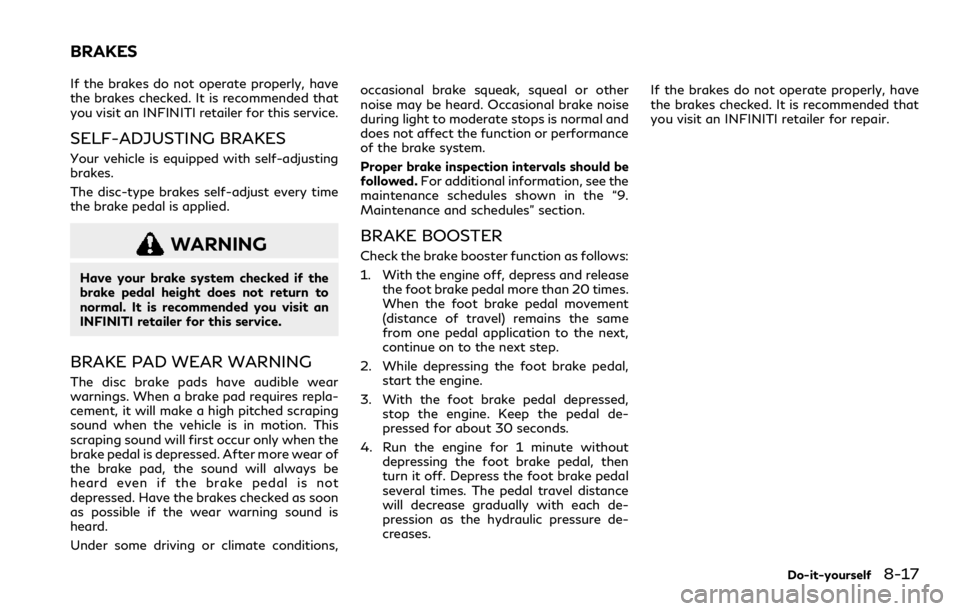
If the brakes do not operate properly, have
the brakes checked. It is recommended that
you visit an INFINITI retailer for this service.
SELF-ADJUSTING BRAKES
Your vehicle is equipped with self-adjusting
brakes.
The disc-type brakes self-adjust every time
the brake pedal is applied.
WARNING
Have your brake system checked if the
brake pedal height does not return to
normal. It is recommended you visit an
INFINITI retailer for this service.
BRAKE PAD WEAR WARNING
The disc brake pads have audible wear
warnings. When a brake pad requires repla-
cement, it will make a high pitched scraping
sound when the vehicle is in motion. This
scraping sound will first occur only when the
brake pedal is depressed. After more wear of
the brake pad, the sound will always be
heard even if the brake pedal is not
depressed. Have the brakes checked as soon
as possible if the wear warning sound is
heard.
Under some driving or climate conditions,occasional brake squeak, squeal or other
noise may be heard. Occasional brake noise
during light to moderate stops is normal and
does not affect the function or performance
of the brake system.
Proper brake inspection intervals should be
followed.
For additional information, see the
maintenance schedules shown in the “9.
Maintenance and schedules” section.
BRAKE BOOSTER
Check the brake booster function as follows:
1. With the engine off, depress and release the foot brake pedal more than 20 times.
When the foot brake pedal movement
(distance of travel) remains the same
from one pedal application to the next,
continue on to the next step.
2. While depressing the foot brake pedal, start the engine.
3. With the foot brake pedal depressed, stop the engine. Keep the pedal de-
pressed for about 30 seconds.
4. Run the engine for 1 minute without depressing the foot brake pedal, then
turn it off. Depress the foot brake pedal
several times. The pedal travel distance
will decrease gradually with each de-
pression as the hydraulic pressure de-
creases. If the brakes do not operate properly, have
the brakes checked. It is recommended that
you visit an INFINITI retailer for repair.
Do-it-yourself8-17
BRAKES
Page 467 of 529

9-6Maintenance and schedules
Brake pads and rotors:
Check for wear, deterioration and fluid
leaks. Replace any deteriorated or damaged
parts immediately.
Exhaust system:
Visually inspect the exhaust pipes, muffler
and hangers for leaks, cracks, deterioration,
and damage. Tighten connections or replace
parts as necessary.
In-cabin microfilter:
Replace at specified intervals. When driving
for prolonged periods in dusty conditions,
replace the filter more frequently.
Propeller shaft(s):
Check for damage, looseness, and grease
leakage. (4WD/RWD)
Steering gear and linkage, axle and suspen-
sion parts, drive shaft boots:
Check for damage, looseness, and leakage
of oil or grease. Under severe driving condi-
tions, inspect more frequently.
Tire rotation:
Rotate tires at the specified interval. When
rotating tires, check for damage and uneven
wear. Replace if necessary.
Transmission fluid/oil, differential oil and
transfer case oil:
Visually inspect for signs of leakage at
specified intervals.To help ensure smooth, safe and economical
driving, INFINITI provides two maintenance
schedules that may be used, depending upon
the conditions in which you usually drive.
These schedules contain both distance and
time intervals, up to 120,000 miles
(192,000 km)/96 months. For most people,
the odometer reading will indicate when
service is needed. However, if you drive very
little, your vehicle should be serviced at the
regular time intervals shown in the schedule.
After 120,000 miles (192,000 km)/96
months, continue maintenance at the same
mileage/time intervals.
ADDITIONAL MAINTENANCE
ITEMS FOR SEVERE OPERATING
CONDITIONS
Additional maintenance items for severe
operating conditions;
should be performed
on vehicles that are driven under especially
demanding conditions. Additional mainte-
nance items should be performed if you
primarily operate your vehicle under the
following conditions:
. Repeated short trips of less than 5 miles
(8 km).
. Repeated short trips of less than 10 miles
(16 km) with outside temperatures re-
maining below freezing. .
Operating in hot weather in stop-and-go
“rush hour” traffic.
. Extensive idling and/or low speed driving
for long distances, such as police, taxi or
door-to-door delivery use.
. Driving in dusty conditions.
. Driving on rough, muddy or salt spread
roads.
. Towing a trailer, using a camper or car-
top carrier.
If your vehicle is mainly operated under the
severe conditions, follow the severe main-
tenance intervals shown in the maintenance
schedule.
MAINTENANCE SCHEDULES
Page 468 of 529

The following shows the maintenance schedule.
Choose the maintenance schedule needed based on your vehicle driving conditions.
After 120,000 miles (192,000 km)/96 months, continue maintenance at the same mileage/time interval.
5,000 Miles/6 Months/8,000 KmStandard maintenance:
Not Applicable. Proceed to next interval.
Severe maintenance:
.Inspect brake pads and rotors.Inspect steering gear and linkage.Inspect axle and suspension parts.Inspect propeller shaft (4WD models).Inspect drive shaft boots (4WD models).Inspect exhaust system.Replace engine oil and filter
7,500 Miles/6 Months/12,000 KmStandard maintenance:.Replace engine oil and filter.Perform tire rotation
Severe maintenance:
Not Applicable. Proceed to next interval.
10,000 Miles/12 Months/16,000
Km
Standard maintenance:
Not Applicable. Proceed to next interval.
Severe maintenance:
.Inspect brake pads and rotors.Inspect steering gear and linkage.Inspect axle and suspension parts.Inspect propeller shaft (4WD models).Inspect drive shaft boots (4WD models).Inspect exhaust system.Replace engine oil and filter.Replace brake fluid
Maintenance and schedules9-7
STANDARD MAINTENANCE